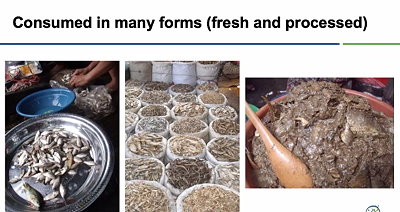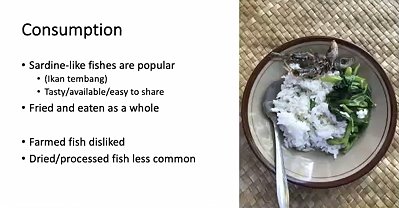Session 3 Consumption behaviour
Maarten Bavinck moderated the session with partners of the Fish4Food Project. The speakers were: Froukje Kruijssen, KIT Royal Tropical Institute, Amsterdam, Netherlands; Ben Belton, Michigan State University, USA, and WorldFish; Akosua K. Darkwah, University of Ghana; Amalendu Jyotishi, Azim Premji University, Bangalore, India; Kyana Dipananda, University of Amsterdam; and Thijs Schut, University of Amsterdam.
Froukje Kruijssen drew attention to observations how social norms influenced consumer behaviours and how urbanisation with associated life style changes impacted preferences for convenience food. She underlined how important it was that pregnant and lactating women and infants in the first 1000 days of their lives had access to a nutritious diet securing health and full cognitive development.
 Ben Belton spoke about artisanal fisheries for small, low-cost freshwater and marine fish in Bangladesh, Myanmar and India. They were consumed fresh or processed in a wide variety of forms. Freshwater fish was getting scarcer as a result of habitat conversion and infrastructure construction, e.g. upstream damming of the Tonle Sap in Cambodia. Ensuing price increases led to substitution of preferred species with aquaculture products and less preferred small marine fish. Heavy fishing pressure and competition between artisanal and industrial marine fishers and diversion of catches into fish meal made it increasingly probable that marine harvests would also become outpriced for financially poor people.
Ben Belton spoke about artisanal fisheries for small, low-cost freshwater and marine fish in Bangladesh, Myanmar and India. They were consumed fresh or processed in a wide variety of forms. Freshwater fish was getting scarcer as a result of habitat conversion and infrastructure construction, e.g. upstream damming of the Tonle Sap in Cambodia. Ensuing price increases led to substitution of preferred species with aquaculture products and less preferred small marine fish. Heavy fishing pressure and competition between artisanal and industrial marine fishers and diversion of catches into fish meal made it increasingly probable that marine harvests would also become outpriced for financially poor people.
Akosua Darkwah reported on work she had carried out together with John Armah on food habits in Jamestown. The common staple was kenkey, based on ground up maize or, earlier, millet, which was always eaten in combination with small fish. As ingredients became more expensive portions where slightly diminished. She considered that this was not an issue as nutritionists were already advising to reduce the carbohydrate intake of the diet. The question was rather whether there would be fish in the future in the light of overfishing and the construction of a huge harbour on the site where small-scale fishers were operating so far.
Amalendu Jyotishi noted that average per capita fish consumption in India was merely 5 kg per year, just 25% of the global average according to FAO estimates (2018). As cities attract huge numbers of poor people from rural areas, it was feared that they could only access fish through markets and that this might restrict consumption. He then explored the differences in fish consumption between Chennai, a coastal city in SE India, and Bangalore situated inland. It turned out that the low income districts studied had similar levels of fish consumption because of taste and because people were aware of the nutritious value. In Chennai marine fish was strongly preferred to freshwater fish. Mobile vendors and nearby markets played a big role in accessibility in both cities.
 Kyana Dipananda had studied access, processing practices and perceptions of fish as food in Madura, a rural area in East Java Province, Indonesia. Fish is a regular part of the diet, mostly boiled. It is characterised as cheap, healthy and tasty. However, cheap fish are only seasonally available. Size and quality of fish matter to people. Bigger fish is "good to eat". Ease of preparation influences choice of species as well. Workers from Madura migrating to urban areas e.g. as shop keepers tend to change to convenience food.
Kyana Dipananda had studied access, processing practices and perceptions of fish as food in Madura, a rural area in East Java Province, Indonesia. Fish is a regular part of the diet, mostly boiled. It is characterised as cheap, healthy and tasty. However, cheap fish are only seasonally available. Size and quality of fish matter to people. Bigger fish is "good to eat". Ease of preparation influences choice of species as well. Workers from Madura migrating to urban areas e.g. as shop keepers tend to change to convenience food.
Thijs Schut studied fish consumption in rural Sumba, Indonesia, and found small fried fish with rice and vegetables was much preferred to cultured fish. Dried fish was rare. Mobile traders play a major role in supplies, sometimes on credit, without which poor people would not have access. Development policies from the capital consider this backwards and promote "modern" aquaculture products.
The discussion about the different case studies highlighted that a one size fits all policy would be highly misplaced. It also dampened the view that central government policy would be the most important factor to analyse and inform as the strength of the informal market channels often worked very efficiently and should not be underestimated. It was noted that urbanisation processes led to changes in food habits.








